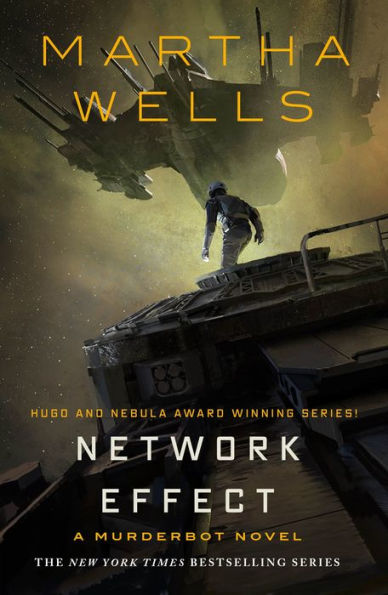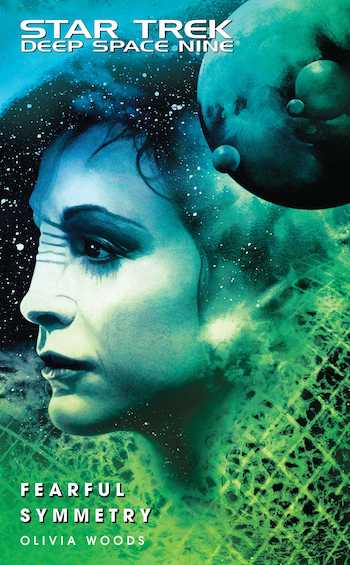Fearful Symmetry
Olivia Woods
Publication Date: June 2008
Timeline: 2377, following the events of Warpath; also, 2357, 2358, 2359, 2360, 2361 and 2375
Progress: This book has a flip format, so that it can be read from either cover, with both stories meeting roughly in the middle of the volume. Mirror, mirror, and all that. These two sections are referred to as Side One and Side Two. Here we go:
Side One: A Prologue set “Seven Days Ago” depicts Sisko having an Orb vision (facilitated by the Orb of Souls) in which he congregates with seven other alternate Siskos. This meeting suggests to Sisko that the Prophets/wormhole aliens originally facilitated contact between our Sisko and the Mirror Universe Sisko (m-Sisko), who is notably absent from the vision gathering, so that the former could in some way inspire or shepherd the latter to play an Emissary role in that realm. After this vision, Sisko discusses the paghvaram–the titular soul key—with Opaka Sulan, and then receives the call from Ezri that will put him at Kira’s bedside when she regains consciousness near the end of Warpath.
Back in the “present,” Mirror Universe Iliana (m-Iliana), now aboard the station, explains that our Iliana is in the Mirror Universe and has very likely replaced their Intendant. m-Iliana tries to enlist the help of the station’s senior crew to stop Iliana in her plan, but they are understandably skeptical. Kira finally decides to use the Orb of Memory, which reveals that she was in fact at the Elemspur Detention Center. She was captured by the Obsidian Order so that her memories could be transferred to Iliana, who was surgically altered to look like her and take her place, and Gul Dukat let Kira out with her memories of Elemspur removed.
Nog helps to rig a device that allows the crew to contact the Mirror Terok Nor, but just as they are making headway in convincing them of who they are, the Alliance attacks Terok Nor and communications are lost. Kira decides to cross over to the Mirror Bajor, and wants to take m-Iliana with her, but Sisko persuades her to take Vaughn instead. Vaughn’s mission, instigated by Sisko’s request, is to find m-Sisko, previously thought dead but still alive, while keeping Kira in the dark about his goal.
* * *
Side Two: We travel back in time to Iliana’s youth, adolescence and early adulthood. She starts out as a somewhat free-thinking artist who is critical of Cardassian politics and of Cardassian rule over Bajor, but the death of her confidante and lover Ataan Rhukal ends up pushing her into the arms of the Obsidian Order. We also learn that Gul Dukat pressured Corbin Entek, who had trained Iliana and was in fact responsible for Ataan’s death (without her knowing it), into dropping his original Kira-replacement plan. Dukat did this so that Iliana, altered to look like Kira and believing herself to be Kira after the memory transplant from the real Kira, would be imprisoned at the Cardassian facility of Letau and essentially serve as Dukat’s personal plaything. The convulsive conclusion to the Dominion War, however, allowed Iliana to escape, and the discovery of her true identity, combined with the prolonged abuse and resulting trauma from her time at Letau, broke her mind and set her on the course we saw in Warpath.
Buy the Book


Network Effect
Behind the lines: I’ve always enjoyed the episode “Second Skin,” but I had no idea it would spawn all this. Goodness. Some aspects of Fearful Symmetry—Sisko’s development and his new sense of purpose regarding m-Sisko, Kira learning more about her own past, and facing a difficult command situation with Vaughn—are enjoyable and well-handled, but there’s quite a bit of material here that left me cold, namely almost all of Iliana’s backstory and arc. Considering that this makes up over half the book, that’s not good. I was also disappointed that the story threads initiated in Warpath didn’t advance except by maybe a few inches.
Let’s begin with positives. Woods is skilled at descriptive prose and dialogue in equal measure, as well as stage-setting and scene construction. This makes for an immersive prose experience. She kicks off her novel with a succinct recap of everything we need to understand and, for the first four or so chapters, manages to maintain a strong forward momentum. She introduces just the right amount of comedic relief with Quark in Side One to ease the tension while keeping the stakes high.
There are neat little moments throughout—like Sisko of the Borg, for instance, in the Prologue. Also, Dax raises good questions early on: “If it really is our Iliana that Taran’atar has followed into the alternate universe, do we leave them for the other side to deal with? Or do we have an obligation to go after them for the crimes that were committed here?” It would have been nice to spend more time on the moral implications of these issues, but the narrative doesn’t pause to breathe life into these dilemmas. Still, I’m grateful that they were articulated and at least briefly addressed.
Woods is also very good with continuity. I thought that Kira reflecting—after chastising Vaughn for losing his perspective—on her own behavior with Silaran Prin was a compelling choice, and in fact her whole exchange with Sisko about their time serving together was excellent. During this conversation Sisko recalls the events of “Rocks and Shoals,” which also struck me as thoughtful and germane. In Side Two, there’s many nods to previous Cardassian worldbuilding. My favorite was Iliana’s reflection on an operative’s “ability to merge with one’s surroundings,” which produced a cool resonance with A Stitch In Time.
Add to this an almost-palpable sense of doom. We get an explicit taste of it in Chapter 3 (“There was a dangerous climate building aboard the station—an unspoken feeling that everything was coming apart”), later echoed in Chapter 8 (“All the tension around here lately—it’s enough to depress anyone,” Quark remarks), but it’s also peppered in through a myriad of descriptive details.
This leads me to Woods’ stylistic choices. Many are quite effective. In Chapter 2, for instance, we get a scene between Kira and m-Iliana from m-Iliana’s perspective rather than from Kira’s, a simple but powerful authorial move that ends up helping us understand both characters better, as opposed to just deepening our insight into Kira. There’s a poignant symmetrical use of the present tense that unifies both Sides: “She [Kira] plunges into darkness for a time and floats among shadows” and “She [Iliana] plunges into darkness for a time and floats among shadows.” The epistolary format, which kicks in during Side Two when Ataan writes to Iliana with news of his various experiences in the field, offers nice insight into their relationship and “humanizes” him as much as possible. Some lines—for example, “Try as she might to find it, her true face eluded her”—work on multiple levels.
Other moves were, I think, less successful. The first few times “what the kosst” is used are cute, but it gets overplayed. In the Prologue, key information about what Sisko is told regarding his mission is deliberately omitted, presumably to generate suspense, but it’s just annoying. The same thing happens again later: crucial information is withheld from us readers when Sisko visits Vaughn in his quarters, for no real reason, and yet again when Sisko informs Vaughn that he can’t tell Kira the truth but declines to explain why. This is not so much elegant narrative misdirection as it is distractingly overt manipulation. It also ties in to the use of flashback scenes, as for example in Chapter 5, which are technically well-executed but break the flow of a story that is already hardly advancing.
This issue becomes particularly troublesome in Side Two, since we essentially know all of the end-states going in. We come to understand why the four characters who assisted Iliana-as-Kira did so, for instance, but since they are already dead it’s hard to care. Expending over a hundred pages on filling in the details of Iliana’s extremely anguished and ultimately brutally violent past is off-putting, and it grinds the narrative to a halt. I don’t mind disturbing scenes or graphic violence if they serve a strong dramatic purpose (see Warpath for an excellent way to accomplish this), but here they felt superfluous and clichéd. I also don’t buy the enormous retconning of Dukat’s prior involvement with the real Kira and the Kira-lookalike that we’re asked to believe here.
Part of the overall problem is that the macro-plot seems to be depending more and more for its resolution on an outcome—the filling of a void in the Mirror Universe that will likely “strengthen the rebellion against the Alliance” and potentially “usher in a new age”—that is both weirdly specific (Sisko’s role) and generally vague (everything else), so as to feel not particularly fleshed out and somewhat arbitrary. The “dire and convoluted circumstances,” as the novel itself refers to them, of the multiple doubles and counterfeit pasts, combined with the stakes depending on the grand-scale evolution of the Mirror Universe rather than the immediate fate of our characters, makes it challenging to become emotionally invested in this story, and, frankly, to become too excited about where this is all headed.
I did appreciate the suggestion that Taran’atar’s character could be redeemed and rehabilitated, but then we get exactly zero progress on his story with Iliana-as-Intendant, which was frustrating. Nor is the grander arc of the forthcoming conflict with the Ascendants pursued. This brings me to my biggest gripe with this book. It’s the first relaunch novel, sadly, that feels non-essential. The Prologue and the few other plot elements from Side One could have made for a tasty short story or novella, and I personally could have done without Side Two entirely. Your parsecs may vary.
Memorable beats: Kira to Vaughn: “… after all the questionable actions you took while I was out of commission…how is it you’re still alive, Commander?”
Kira, when asked by m-Iliana what she requests of the Prophets: “I don’t ask them for anything. I look inward for the virtues the Prophets have taught us to cultivate. Wisdom…strength…hope.”
Major Cenn reflecting on life aboard DS9: “Being on Deep Space 9 often felt like the surreal consequences of a night spent drinking far too much copal.”
Quark’s wisdom: “When in doubt, tug on the lobes of your elders. ”
And Quark again: “People love the bartender; Rule of Acquisition Number 147. Why do you think I took up mixology in the first place?”
Ro recalling her affection for Taran’atar: “He was always—himself. I don’t know how else to explain it. He wasn’t trying to assimilate, to become more like the rest of us.”
Kira to m-Iliana, as eloquent as ever: “You’re the double of a woman who was surgically altered to replace me, but who has instead replaced my double in an alternate universe.”
Best Ferengi moment in the relaunch? “Nog knew in his lobes that this was one of those times when the dividends to the many outvalued the dividends to the few. Or the one.”
Orb factor: A few interesting notions, but overlong, and grimly unpleasant without a justifying payoff; 6 orbs.
In our next installment: We’ll be back in this space on Wednesday May 27th with The Soul Key by Olivia Woods!
Alvaro is a Hugo- and Locus-award finalist who has published some forty stories in professional magazines and anthologies, as well as over a hundred essays, reviews, and interviews. Nag him @AZinosAmaro.










